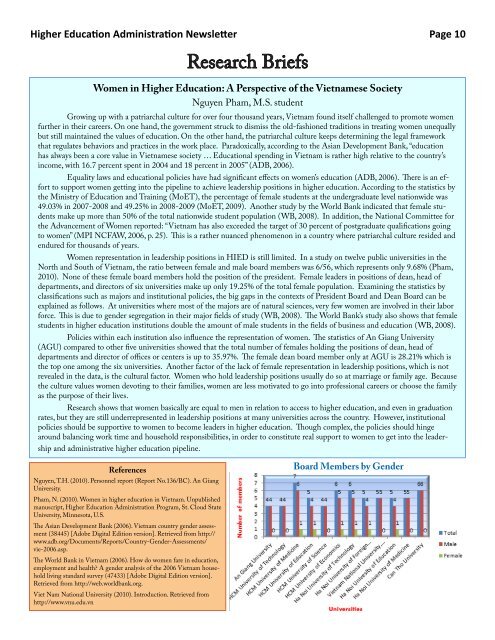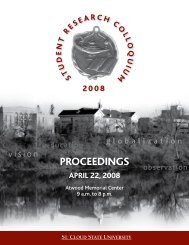Inside this issue: - St. Cloud State University
Inside this issue: - St. Cloud State University
Inside this issue: - St. Cloud State University
Create successful ePaper yourself
Turn your PDF publications into a flip-book with our unique Google optimized e-Paper software.
Higher Education Administration Newsletter Page 10<br />
Research Briefs<br />
Women in Higher Education: A Perspective of the Vietnamese Society<br />
Nguyen Pham, M.S. student<br />
Growing up with a patriarchal culture for over four thousand years, Vietnam found itself challenged to promote women<br />
further in their careers. On one hand, the government struck to dismiss the old-fashioned traditions in treating women unequally<br />
but still maintained the values of education. On the other hand, the patriarchal culture keeps determining the legal framework<br />
that regulates behaviors and practices in the work place. Paradoxically, according to the Asian Development Bank, “education<br />
has always been a core value in Vietnamese society … Educational spending in Vietnam is rather high relative to the country’s<br />
income, with 16.7 percent spent in 2004 and 18 percent in 2005” (ADB, 2006).<br />
Equality laws and educational policies have had significant effects on women’s education (ADB, 2006). There is an effort<br />
to support women getting into the pipeline to achieve leadership positions in higher education. According to the statistics by<br />
the Ministry of Education and Training (MoET), the percentage of female students at the undergraduate level nationwide was<br />
49.03% in 2007-2008 and 49.25% in 2008-2009 (MoET, 2009). Another study by the World Bank indicated that female students<br />
make up more than 50% of the total nationwide student population (WB, 2008). In addition, the National Committee for<br />
the Advancement of Women reported: “Vietnam has also exceeded the target of 30 percent of postgraduate qualifications going<br />
to women” (MPI NCFAW, 2006, p. 25). This is a rather nuanced phenomenon in a country where patriarchal culture resided and<br />
endured for thousands of years.<br />
Women representation in leadership positions in HIED is still limited. In a study on twelve public universities in the<br />
North and South of Vietnam, the ratio between female and male board members was 6/56, which represents only 9.68% (Pham,<br />
2010). None of these female board members hold the position of the president. Female leaders in positions of dean, head of<br />
departments, and directors of six universities make up only 19.25% of the total female population. Examining the statistics by<br />
classifications such as majors and institutional policies, the big gaps in the contexts of President Board and Dean Board can be<br />
explained as follows. At universities where most of the majors are of natural sciences, very few women are involved in their labor<br />
force. This is due to gender segregation in their major fields of study (WB, 2008). The World Bank’s study also shows that female<br />
students in higher education institutions double the amount of male students in the fields of business and education (WB, 2008).<br />
Policies within each institution also influence the representation of women. The statistics of An Giang <strong>University</strong><br />
(AGU) compared to other five universities showed that the total number of females holding the positions of dean, head of<br />
departments and director of offices or centers is up to 35.97%. The female dean board member only at AGU is 28.21% which is<br />
the top one among the six universities. Another factor of the lack of female representation in leadership positions, which is not<br />
revealed in the data, is the cultural factor. Women who hold leadership positions usually do so at marriage or family age. Because<br />
the culture values women devoting to their families, women are less motivated to go into professional careers or choose the family<br />
as the purpose of their lives.<br />
Research shows that women basically are equal to men in relation to access to higher education, and even in graduation<br />
rates, but they are still underrepresented in leadership positions at many universities across the country. However, institutional<br />
policies should be supportive to women to become leaders in higher education. Though complex, the policies should hinge<br />
around balancing work time and household responsibilities, in order to constitute real support to women to get into the leadership<br />
and administrative higher education pipeline.<br />
References<br />
Nguyen, T.H. (2010). Personnel report (Report No.136/BC). An Giang<br />
<strong>University</strong>.<br />
Pham, N. (2010). Women in higher education in Vietnam. Unpublished<br />
manuscript, Higher Education Administration Program, <strong>St</strong>. <strong>Cloud</strong> <strong>St</strong>ate<br />
<strong>University</strong>, Minnesota, U.S.<br />
The Asian Development Bank (2006). Vietnam country gender assessment<br />
(38445) [Adobe Digital Edition version]. Retrieved from http://<br />
www.adb.org/Documents/Reports/Country-Gender-Assessments/<br />
vie-2006.asp.<br />
The World Bank in Vietnam (2006). How do women fare in education,<br />
employment and health? A gender analysis of the 2006 Vietnam household<br />
living standard survey (47433) [Adobe Digital Edition version].<br />
Retrieved from http://web.worldbank.org.<br />
Viet Nam National <strong>University</strong> (2010). Introduction. Retrieved from<br />
http://www.vnu.edu.vn<br />
Board Members by Gender
















